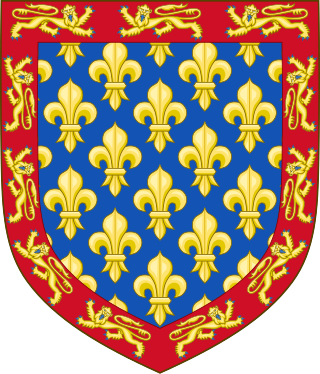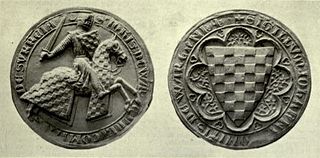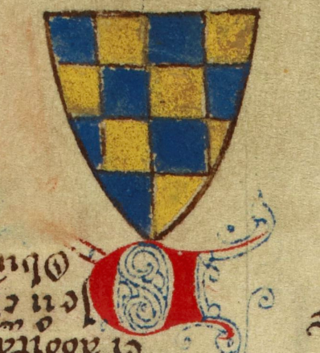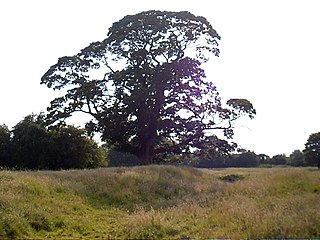Related Research Articles

Hamelin de Warenne, Earl of Surrey, was an Anglo-Angevin nobleman, being an elder half-brother of the first Plantagenet English monarch King Henry II.

Earl of Surrey is a title in the Peerage of England that has been created five times. It was first created for William de Warenne, a close companion of William the Conqueror. It is currently held as a subsidiary title by the Dukes of Norfolk.

John de Warenne, 6th Earl of Surrey was a prominent English nobleman and military commander during the reigns of Henry III of England and Edward I of England. During the Second Barons' War he switched sides twice, ending up in support of the king, for whose capture he was present at Lewes in 1264. Warenne was later appointed as "warden of the kingdom and land of Scotland" and featured prominently in Edward I's wars in Scotland.
William de Warenne, 1st Earl of Surrey, Lord of Lewes, Seigneur de Varennes, was a Norman nobleman created Earl of Surrey under William II Rufus. He is among the few known from documents to have fought under William the Conqueror at the Battle of Hastings in 1066. At the time of the Domesday Book in 1086, he held extensive lands in 13 counties, including the Rape of Lewes, a tract now divided between the ceremonial counties of East Sussex and West Sussex.

William de Warenne, 2nd Earl of Surrey was the son of William de Warenne, 1st Earl of Surrey and his first wife Gundred. He was more often referred to as Earl Warenne or Earl of Warenne than as Earl of Surrey.
William de Warenne, 3rd Earl of Surrey was an Anglo-Norman nobleman, member of the House of Warenne, who fought in England during the Anarchy and generally remained loyal to King Stephen. He participated in, and ultimately perished during, the Second Crusade.

William de Warenne, 5th Earl of Surrey was the son of Hamelin de Warenne and Isabel, daughter of William de Warenne, 3rd Earl of Surrey. His father Hamelin granted him the manor of Appleby, North Lincolnshire.

John de Warenne, 7th Earl of Surrey, was the last Warenne earl of Surrey.

Meaux Abbey was a Cistercian abbey founded in 1151 by William le Gros, 1st Earl of Albemarle, Earl of York and 4th Lord of Holderness, near Beverley in the East Riding of Yorkshire, England.

William I, also referred to as William of Blois, was Count of Boulogne and Earl of Surrey jure uxoris from 1153 until his death. He was the second son of Stephen, King of England, and Matilda I, Countess of Boulogne.
Gundred or Gundreda was the Flemish-born wife of an early Norman baron, William de Warenne, 1st Earl of Surrey. She and her husband established Lewes Priory in Sussex.

Castle Acre is a village and civil parish in the English county of Norfolk. The village is situated on the River Nar some 4 miles (6.4 km) north of the town of Swaffham. It is 15 miles (24 km) east of the town of King's Lynn, 33 miles (53 km) west of the city of Norwich, and 103 miles (166 km) from London.

Lewes Priory is a part-demolished medieval Cluniac priory in Lewes, East Sussex in the United Kingdom. The ruins have been designated a Grade I listed building.
Isabel de Warenne, 4th Countess of Surrey was an English peer. She was the only surviving heir of William de Warenne, 3rd Earl of Surrey, and his wife, Adela, the daughter of William III of Ponthieu.
Alice de Lusignan, Countess of Surrey was a uterine half-sister of King Henry III of England and the wife of John de Warenne, 6th Earl of Surrey. Shortly after her arrival in England from France in 1247, her half-brother arranged her marriage to the Earl, which incurred some resentment from the English nobility.
Alice de Warenne, Countess of Arundel was an English noblewoman and heir apparent to the Earldom of Surrey. In 1305, she married Edmund FitzAlan, 2nd Earl of Arundel.
Maud Marshal, Countess of Norfolk, Countess of Surrey was an Anglo-Norman noblewoman and a wealthy co-heiress of her father William Marshal, 1st Earl of Pembroke, and her mother Isabel de Clare suo jure 4th Countess of Pembroke. Maud was their eldest daughter. She had two husbands: Hugh Bigod, 3rd Earl of Norfolk, and William de Warenne, 5th Earl of Surrey.

Gerbod the Fleming, of Oosterzele, 1st Earl of Chester, was a hereditary advocate of the Abbey of Saint Bertin at Saint-Omer, County of Flanders and Earl of Chester in 1070.
William de Warenne was the only son of John de Warenne, 6th Earl of Surrey and his wife Alice de Lusignan.

The de Warenne family were a noble family in England that included the first Earls of Surrey, created by William the Conqueror in 1088 for William de Warenne, 1st Earl of Surrey, who was among his companions at the Battle of Hastings. The family originated in Normandy and, as Earls, held land there and throughout England. When the senior male-line ended in the mid-12th century, the descendants of their heiress adopted the Warenne surname and continue as Earls of Surrey for another two centuries. Several junior lines also held land or prominent offices in England and Normandy.
References
Primary sources
- Edwards, E, ed. (1866). Liber Monasterii de Hyda: Comprising a Chronicle of the Affairs of England, From the Settlement of the Saxons to the Reign of King Cnut, and a Chartulary of the Abbey of Hyde, in Hampshire, A.D. 455–1023. Rerum Britannicarum Medii Ævi Scriptores. London: Longmans, Green, Reader, and Dyer – via Internet Archive.
Secondary sources
- ↑ Kennedy, ED (2016). "Warenne Chronicle". In Dunphy, G; Bratu, C (eds.). Encyclopedia of the Medieval Chronicle. doi:10.1163/2213-2139_emc_SIM_001353 – via BrillOnline Reference Works.
- ↑ Van Houts, Elisabeth, and Rosalind Love. The Warenne (Hyde) Chronicle. Vol. 67. Oxford University Press, 2013. pxii